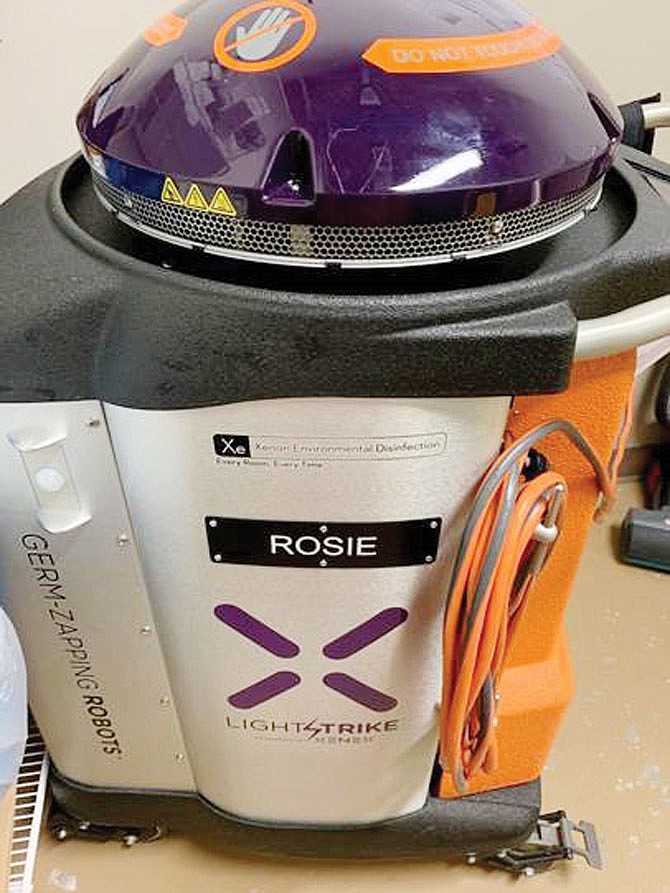[<a href="https://www.newstribune.com/news/health/" style="color:#33AEFF">access the News Tribune Health section</a>]
Jefferson City's hospitals are leaning on technology to help prevent the spread of COVID-19.
Even before the threat posed by the current pandemic, hospitals faced significant challenges preventing hospital-acquired infections.
Each year, about one in 25 hospital patients nationwide is diagnosed with an infection related to hospital care, according to the Centers for Disease Control and Prevention.
Capital Region Medical Center and St. Mary's Hospital are using ultraviolet light to kill infections within their facilities.
CRMC installed a UV disinfecting device this week. The device is used to disinfect materials, like masks. It is the first of its kind to be deployed in the United States, according to a CRMC news release. It is capable of disinfecting 36 N95 masks in two minutes.
The device prolongs the usefulness of the masks, according to the release.
Last week, the St. Mary's Hospital Foundation approved the purchase of an ultraviolet light infection control robot for the Jefferson City hospital.
The robot - which cost $100,000 - is the second UV robot to be used in the hospital.
The hospital's auxiliary, a nonprofit organization dedicated to serving the needs and mission of the hospital, purchased a similar robot in 2019. Consisting of more than 270 members, the auxiliary staffs the hospital's volunteer services, said Bev Stafford, the foundation's director. During typical years, members of the auxiliary volunteer for more than 40,000 hours at the hospital. They conduct fundraisers like the annual ice cream social and operate the hospital gift shop.
The robot, which is shaped similarly to a shop-vac, extends a light from the top until it is about 5 feet tall, then emits pulses of ultraviolet light to render bacteria and viruses inactive. The UV light can kill pathogens, such as MRSA, mold, measles and coronaviruses.
UV robots are an added layer of protection hospitals may provide against the spread of disease and infections, according to a hospital news release.
"The robot provides that level of advanced technology that we know is protecting our patients, that we know is protecting our staff, that is working overtime these days. It works many hours keeping our Emergency Department clean and safe," Stafford said. "The second one means we can cover all of our floors and areas, in addition to the Emergency Department, in a timely fashion."
The foundation, a 501(c)(3) organization, accepts major gifts and memorials, which allow it to meet its mission to bring technical advancements to the hospital, she said. With the current environment in health care, it's important to be able to react quickly to the hospital's needs. Having the foundation allows the hospital to purchase the robot and other equipment that can have a positive effect.
The first robot, which staff nicknamed "Rosie," aids the hospital's environmental services team in cleaning patient rooms, supply areas and equipment after they undergo manual cleaning.
"This is a wonderful tool for the hospital, and it has a demonstrated ability to reduce hospital-acquired infections," Jackie Glover, infection preventionist for the hospital, said in a news release.
The second robot should be delivered about the end of the month.
The foundation has contributed more than $15 million to the hospital for new technology and equipment, employee scholarships and the land on which the new hospital stands.
The foundation Friday also approved the $40,000 purchase of two automated chest compression devices - one for the Emergency Department and one for inpatient areas.
Under the current coronavirus pandemic, when someone has heart failure and a team is dispatched to keep that person alive, the situation can be challenging, said Mike Hyde, chief nursing officer at the hospital. The most physically difficult part of a response is providing chest compressions.
"Typically we have to rotate people because it's not physically sustainable," Hyde said. "With the current concerns about exposure, we would end up with multiple people exposed to a patient. Also, doing chest compressions is the one activity most likely to dislodge a team member's mask due to the physical activity and expose them to a COVID-19 patient."
Automated devices can be attached to the patient and provide the chest compressions automatically, without the need for multiple people to do it, he continued. The device could save lives for the patients and the teams.
The chest compressors are expected to be delivered next week.

